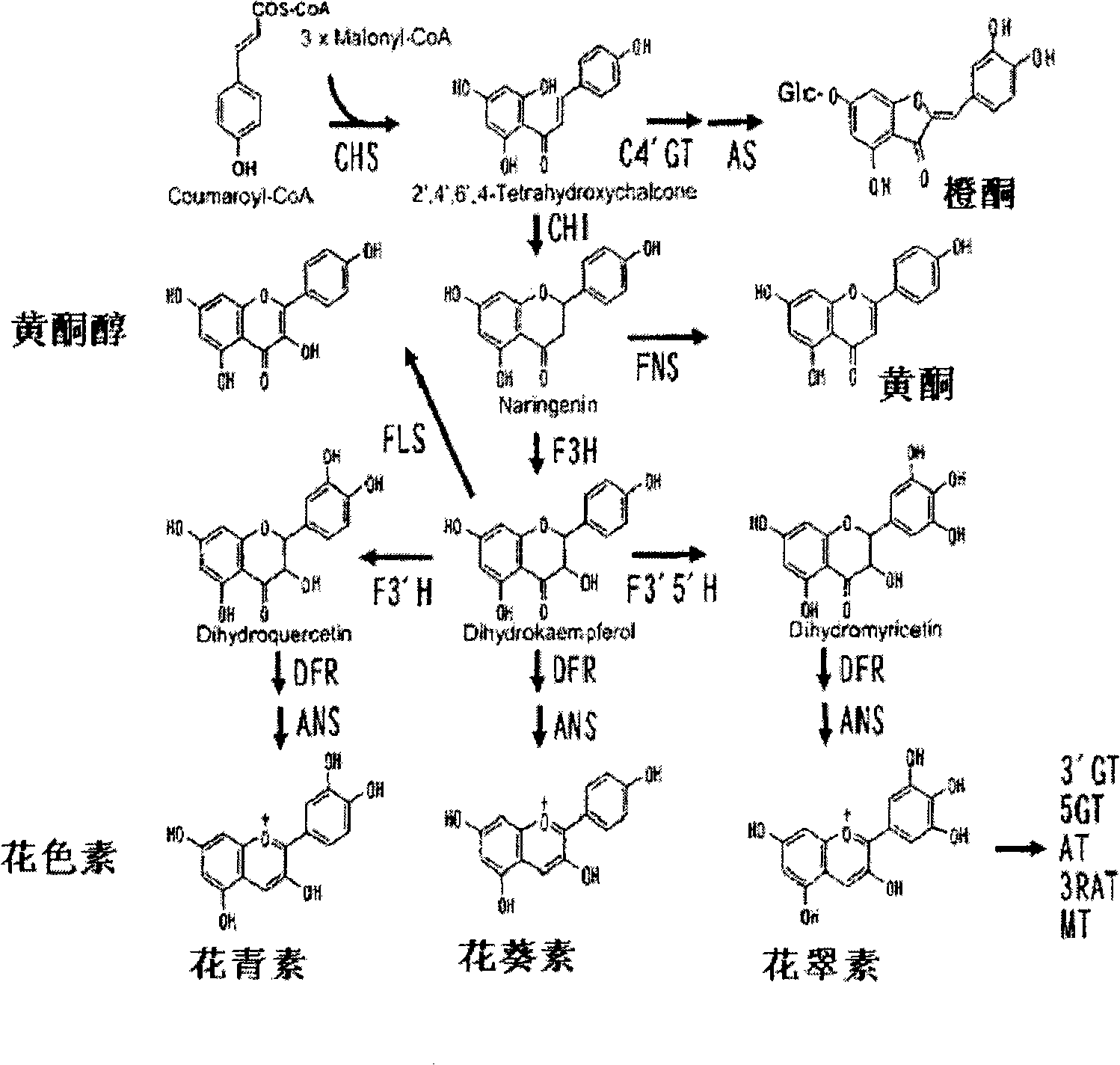Rose containing flavone, and method for production thereof
A technology of flavonoids and Chinese roses, which is applied to roses containing flavonoids and its production field, and can solve the problems of failing to accumulate flavonoids
- Summary
- Abstract
- Description
- Claims
- Application Information
AI Technical Summary
Problems solved by technology
Method used
Image
Examples
Embodiment 1
[0107] Example 1: Simulation of the co-coloring effect of flavonoids on anthocyanins
[0108] In order to simulate the co-coloring effect of flavonoids on anthocyanins, anthocyanins were first prepared. Cyanin is extracted and purified from the petals of the Chinese rose variety "Rote Rose" (rose cv. "Rote Rose"). Delphin will be obtained from the verbena variety "Tapien Violet" (vberbena cv. "Tapien Violet" or vberbena variety Sunmaref TP-V ("Tapien Violet") ("Tapien" is a Trade Mark registered in Japan) ) in the petals of the pigment extracted by alkaline hydrolysis and purification. Malvin and Luteolin 7-O-glucoside were purchased from Funakoshi Co., Ltd., Japan.
[0109] Among the various anthocyanins thus prepared, flavonoids (Luteolin 7-O-glucoside (Luteolin 7-O-glucoside)) were prepared at pH 5.0 buffer at 0, 1, 2, 4 Equivalent molar concentration ratio was added, and the absorption spectrum was measured. As anthocyanins, Cyanin (Cyanidin 3,5-diglucoside (Cyanidin 3...
Embodiment 2
[0118]Example 2 (reference example): Introducing the F3'5'H#40 gene from pansy and the flavone synthase gene from perilla into the rose variety "Lavande"
[0119] The plasmid pYFS3 containing the flavone synthase gene from perilla described in Japanese Patent Application Laid-Open No. 2000-279182, pYFS3 was digested with XbaI, blunted at the end, and further digested with BamHI to obtain perilla flavone synthase of about 1.8 kb Gene fragment. On the other hand, pSPB906 described in WO2005 / 017147 was digested with XhoI, blunted at the end, and further digested with BamHI. Between this blunt end and the BamHI cleavage site, insert the aforementioned perilla flavone synthase gene fragment to obtain 906-pYFS3. 906-pYES3 is in the El 2 There is a perilla-derived flavone synthase gene between the 35S promoter and the D8 terminator (both described in WO2005 / 017147).
[0120] The BamHI and SalI sites of pSPB176 described in the report of Ueyama et al. (Ueyama et al. Plant Science, 1...
Embodiment 3
[0129] Example 3: Introducing the F3'5'H#40 gene from Pansy and the flavone synthase gene from Butterfly into the rose variety "Lavande"
[0130] The pSPB426 was obtained by inserting the Butterfly-derived flavone synthase gene into the EcoRI and XhoI sites of plasmid pBluescript IISK(-) described in the report by Akashi et al. (Plant Cell Physiol 40, 1182-1186, 1999). After digesting it with KpnI, the end was smoothed, and further digested with BamHI to obtain a flavone synthase gene fragment of about 1.7 kb from Papilionaceae. On the other hand, pSPB906 described in WO2005 / 017147 was digested with XhoI, blunted at the end, and further digested with BamHI. Between the blunt end and the BamHI cutting site, the aforementioned flavone synthase gene fragment of Butterfly grass was inserted to obtain 906-426.
[0131] At the BamHI and SalI sites of pSPB176 described in the report of Ueyama et al. (Ueyama et al. Plant Science, 163, 253-263, 2002), the partial digestion with BamHI ...
PUM
 Login to View More
Login to View More Abstract
Description
Claims
Application Information
 Login to View More
Login to View More - R&D
- Intellectual Property
- Life Sciences
- Materials
- Tech Scout
- Unparalleled Data Quality
- Higher Quality Content
- 60% Fewer Hallucinations
Browse by: Latest US Patents, China's latest patents, Technical Efficacy Thesaurus, Application Domain, Technology Topic, Popular Technical Reports.
© 2025 PatSnap. All rights reserved.Legal|Privacy policy|Modern Slavery Act Transparency Statement|Sitemap|About US| Contact US: help@patsnap.com



